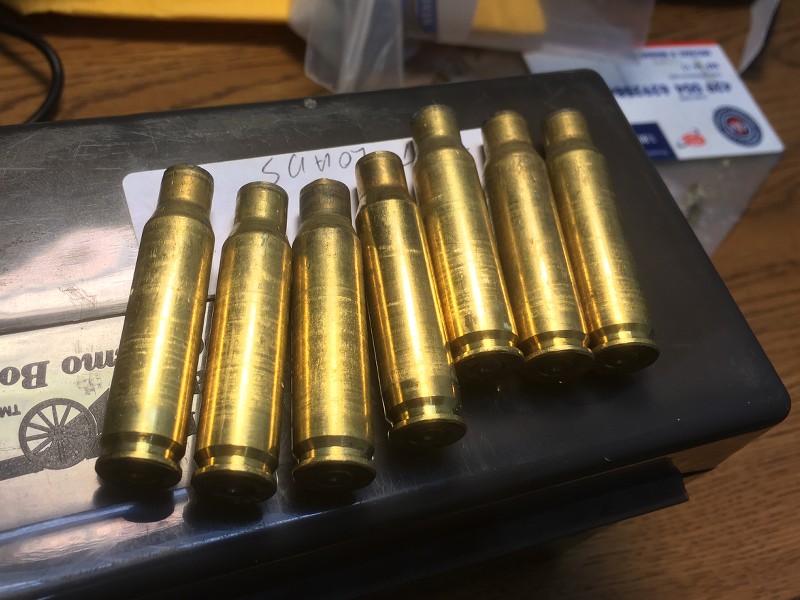Tool marks from my chamber ?

These cases were fired in a new AR-10 type upper I bought recently . I originally thought they were tooling marks imprinted on the cases when fired . I how ever now have another thought .
When I first received the upper I ran a bore snake through the barrel then tested a the headspace with a GO and NOGO gauge . It passed both or so I thought . I did not strip the bolt and how I tested it was to ride the charging handle home then use the forward assist to force the bolt closed . It worked on the GO gauge and appeared to work on the NOGO gauge .
On the NOGO I felt and heard the bolt snap over the extractor while pushing several times on the forward assist but the bolt did not go into full battery . I at the time wrongly assumed this meant the bolt passed the NOGO gauge as well . Fast forward to a few days ago and me measuring the head to datum measurement on the cases I fired and they all are coming out .004+ longer then my Forster NOGO gauge measures .
So I tried the NOGO gauge again with out stripping the bolt but this time I had the upper off the lower and used a light rubber mallet to hit the base of the BCG to force the bolt closed . I gave it a couple firm hits ( not hard by any stretch ) and sure enough the bolt went into full battery on the NOGO gauge . Unfortunately I don't own a field gauge in this cartridge but I don't think it matters because it should not fail the NOGO gauge so it's going back regardless .
Unfortunately I don't own a field gauge in this cartridge but I don't think it matters because it should not fail the NOGO gauge so it's going back regardless .
OK now all that said . I'm already getting casehead stretch at the web on factory new ammo fired in this upper that are already failing the paper clip test So not only is the headspace long , it may be dangerously long which brings me to my over all question .
So not only is the headspace long , it may be dangerously long which brings me to my over all question .
Can those marks on the cases be stretch marks along the length of the case ? Meaning the case is stretching in multiple locations along the case body and not just the web do to the excessive headspace problem I appear to be having ?
Or what about scratch marks created as the case slides back to the bolt face under reduced pressure just before extraction or even upon extraction when still under some pressure ??
FWIW I have a email into the manufacture asking for return and repair/replace . I'm assuming since the 308 AR platform does not have a shared industry standard barrel extension and bolt dimensions . Rather then replacing the barrel they will likely just find a bolt that gives the correct headspace ???
Anyways what do you think ?
MG

These cases were fired in a new AR-10 type upper I bought recently . I originally thought they were tooling marks imprinted on the cases when fired . I how ever now have another thought .
When I first received the upper I ran a bore snake through the barrel then tested a the headspace with a GO and NOGO gauge . It passed both or so I thought . I did not strip the bolt and how I tested it was to ride the charging handle home then use the forward assist to force the bolt closed . It worked on the GO gauge and appeared to work on the NOGO gauge .
On the NOGO I felt and heard the bolt snap over the extractor while pushing several times on the forward assist but the bolt did not go into full battery . I at the time wrongly assumed this meant the bolt passed the NOGO gauge as well . Fast forward to a few days ago and me measuring the head to datum measurement on the cases I fired and they all are coming out .004+ longer then my Forster NOGO gauge measures .
So I tried the NOGO gauge again with out stripping the bolt but this time I had the upper off the lower and used a light rubber mallet to hit the base of the BCG to force the bolt closed . I gave it a couple firm hits ( not hard by any stretch ) and sure enough the bolt went into full battery on the NOGO gauge .
OK now all that said . I'm already getting casehead stretch at the web on factory new ammo fired in this upper that are already failing the paper clip test
Can those marks on the cases be stretch marks along the length of the case ? Meaning the case is stretching in multiple locations along the case body and not just the web do to the excessive headspace problem I appear to be having ?
Or what about scratch marks created as the case slides back to the bolt face under reduced pressure just before extraction or even upon extraction when still under some pressure ??
FWIW I have a email into the manufacture asking for return and repair/replace . I'm assuming since the 308 AR platform does not have a shared industry standard barrel extension and bolt dimensions . Rather then replacing the barrel they will likely just find a bolt that gives the correct headspace ???
Anyways what do you think ?
MG
Last edited:
